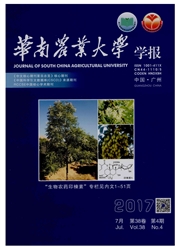

 中文摘要:
中文摘要:
采用温室盆栽试验,研究灭菌与非灭菌土壤条件下2个品种水稻(GN和IR)幼苗对ClO4-(高氯酸盐)污染的响应.结果表明:无ClO4^-污染时,土壤灭菌可促进2个品种水稻的株高、根长和生物量的增长,但有ClO4^-污染时,灭菌处理反而显著抑制水稻生长;当施入ρ(ClO4^-)为0.1 mg/L时,土壤灭菌降低了水稻对ClO4^-的吸收积累,非灭菌组GN和IR分别有69.70%和88.55%的ClO4^-迁移到植物体内,而灭菌组则分别有21.55%和13.98%的ClO4^-迁移到植物体内;ρ(ClO4^-)为50.0 mg/L时,土壤灭菌反而增加了水稻对ClO4^-的吸收积累,灭菌组GN和IR叶片中的w(ClO4^-)分别是非灭菌组的3.67和5.88倍,但无论土壤是否灭菌,迁移到植物体内的ClO4^-所占比例均小于2%;灭菌组93%以上的ClO4^-残留在土壤中,而非灭菌组则有98%以上的ClO4^-转化成为其他物质.土壤灭菌、ρ(ClO4^-)为50 mg/L处理能够显著降低土壤脲酶和过氧化氢酶的活性.
 英文摘要:
英文摘要:
Perchlorate contamination is a serious problem because of its potential toxicity and health effects, adverse impacts on ecosystems, and possible indirect exposure pathways to humans. Therefore, it is urgent to reduce the perchlorate uptake by crops and speed up perchlorate degradation in the agro-ecosystem. A pot experiment was conducted to determine the effects of perehlorate on growth and chlorophyll content of two rice variety seedlings in sterilized and non-sterilized soils, and its accumulation in the rice plant. The distribution, migration and transformation of perchlorate in the soil-rice system were also investigated. The results showed that soil sterilization resulted in the promotion of rice plant height, root length, biomass and chlorophyll content when treated without perchlorate, whereas soll sterilization inhibited the growth of the two rice varieties significantly when treated with perehlorate. At the end of the pot experiment, perchlorate concentrations in roots, stems and leaves of two rice varieties planted in the sterilized soil were significantly less than those in the non-sterilized soil at low perchlorate concentration (0.1 rag/L). In non-sterilized soil, 69.70% and 88.55% of perehlorate were absorbed by the two rice varieties respectively, while in sterilized soil the levels were 21.55% and 13.98%. However,perchlorate concentrations in each organ of the two rice varieties in sterilized soil were significantly higher than those in non-sterilized soil with high perchlorate level (50. 0 mg/L). The content of perchlorate in the two varieties of rice leaves in sterilized soil were 3.67 and 5.88 times as those in non-sterilized soil. This indicated that soil sterilization could slow down the accumulation of perchlorate in rice plants at low perchlorate levels, whereas it could speed up the accumulation of perchlorate in rice at high levels. The higher the treatment concentration of perchlorate, the higher the amount of perchlorate accumulation in the plant. Perchlorate amounts accumulated
 同期刊论文项目
同期刊论文项目
 同项目期刊论文
同项目期刊论文
 期刊信息
期刊信息
